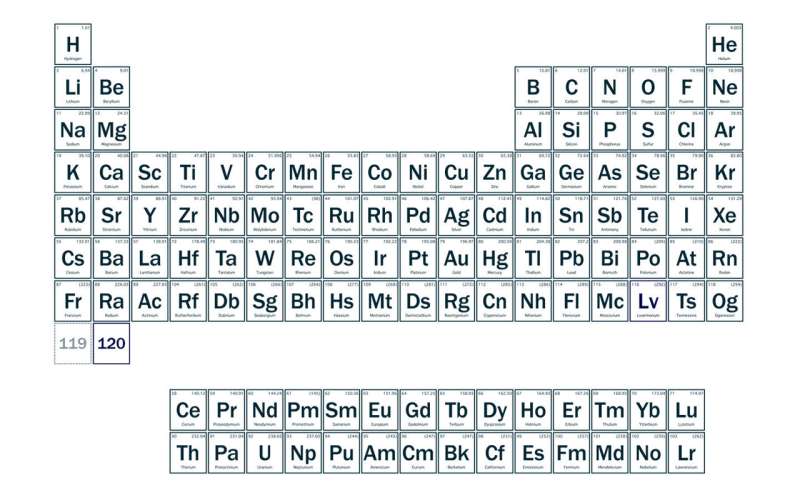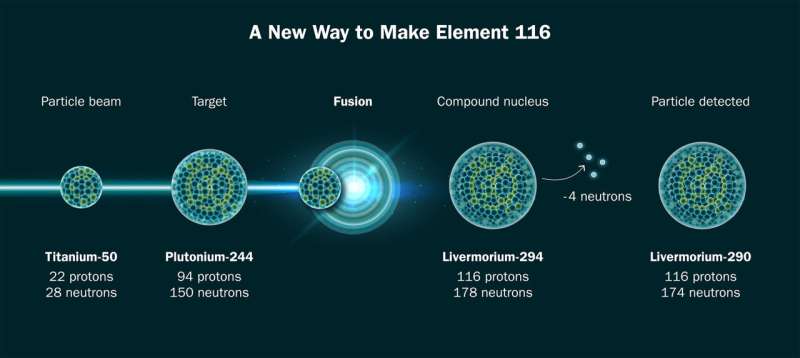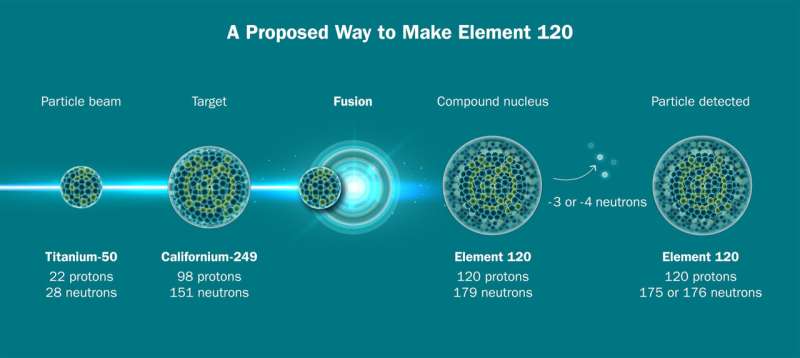
Scientist Jacklyn Gates at the Berkeley Gas-filled Separator used to separate atoms of element 116, livermorium. Credit: Marilyn Sargent/Berkeley Lab
Scientists at the Department of Energy’s Lawrence Berkeley National Laboratory (Berkeley Lab) have discovered 16 of the 118 known elements. Now they have taken the first crucial step toward potentially creating another element: element 120.
Today, an international team of researchers led by Berkeley Lab’s Heavy Element Group announced that they have discovered superheavy element 116 using a titanium beam, a breakthrough that is a key step toward making element 120. The result was presented today at the Nuclear Structure 2024 conference; the scientific paper will be published in the online repository arXiv and was submitted to the journal Physical Exam Letters.
“This reaction had never been demonstrated before, and it was critical to prove it was possible before we embarked on our attempt to make 120,” said Jacklyn Gates, a nuclear scientist at Berkeley Lab who is leading the effort. “Creating a new element is an extremely rare feat. It’s exciting to be part of the process and have a promising path forward.”
The team managed to make two atoms of element 116, livermorium, during 22 days of operation in the lab’s heavy-ion accelerator, the 88-inch cyclotron. Making an atom of element 120 would be even rarer, but judging by the speed at which they produced 116, it’s a reaction scientists could reasonably look for over several years.
“We needed nature to be kind, and it was,” said Reiner Kruecken, director of Berkeley Lab’s nuclear sciences division. “We think it will take about 10 times longer to make 120 than 116. It’s not easy, but it looks feasible now.”
If discovered, element 120 would be the heaviest atom ever created and would be found in the eighth row of the periodic table. It lies on the shores of the “island of stability,” a theoretical group of superheavy elements with unique properties.
While the superheavy elements discovered so far decay almost instantly, the right combination of protons and neutrons could create a more stable nucleus that can survive longer, giving researchers a better chance of studying it. Exploring elements at the extremes can provide insights into the behavior of atoms, test models of nuclear physics, and map the limits of atomic nuclei.

A detailed periodic table shows where researchers expect elements 119 and 120 to fall if discovered. Credit: Marilyn Sargent/Berkeley Lab
Manufacturing of superheavy elements
The recipe for making superheavy elements is simple in theory. Just combine two lighter elements that, when combined, have the desired number of protons in the final atom. It’s a basic mathematical formula: 1+2=3.
In practice, this is obviously extremely difficult. It can take billions of interactions before two atoms fuse, and there are limits to what can reasonably be turned into a particle beam or target.
Researchers choose specific isotopes—variants of elements that have the same number of protons but different numbers of neutrons—for their beam and target. The heaviest practical target is an isotope called californium-249, which has 98 protons. (A heavier target, such as fermium with 100 protons, would decay too quickly.) That means that to try to make element 120, researchers can’t use their usual beam of calcium-48 with its 20 protons. Instead, they need a beam of atoms with 22 protons: titanium, an element not commonly used to make superheavy elements.
Experts at the 88-inch cyclotron set out to verify that they could produce a sufficiently intense beam of the isotope titanium-50 over a period of weeks and use it to make element 116, the heaviest element ever made at Berkeley Lab.
Until now, elements 114 to 118 had only been obtained using a beam of calcium-48, which has a special or “magic” configuration of neutrons and protons that allows it to fuse with target nuclei to produce superheavy elements. Whether it would even be possible to create superheavy elements near the island of stability using a “non-magic” beam such as titanium-50 remained an open question in the field.
“This was an important first step in trying to create something a little simpler than a new element to see how going from a calcium beam to a titanium beam changes the rate at which we produce these elements,” said Jennifer Pore, a scientist in Berkeley Lab’s Heavy Elements Group.
“When we try to produce these incredibly rare elements, we are at the absolute limit of human knowledge and understanding, and there is no guarantee that the physics will work as we hope. The creation of element 116 with titanium confirms that this production method works, and we can now plan our hunt for element 120.”
The project to manufacture superheavy elements using Berkeley Lab’s unique facilities is included in the Nuclear Science Advisory Committee’s 2023 long-range plan for nuclear science.

To make element 116, researchers fused isotopes of titanium and plutonium. Credit: Jenny Nuss/Berkeley Lab
Engineering feats
Creating a sufficiently intense beam of titanium isotopes is no easy task. The process begins with a special piece of titanium-50, a rare isotope of titanium that makes up about 5 percent of all titanium in the ground. This piece of metal is placed in a furnace about the size of the last segment of your pinky finger. The furnace heats the metal until it begins to vaporize, like the gas from dry ice, at nearly 1,500 degrees Celsius.
All this takes place in an ion source called VENUS, a complex superconducting magnet that acts like a bottle confining a plasma. Free electrons spiral through the plasma, gaining energy when bombarded by microwaves and knocking 12 of the titanium’s 22 electrons off. Once charged, the titanium can be maneuvered by magnets and accelerated in the 88-inch cyclotron.
“We knew these high-current titanium beams would be tricky because titanium reacts with many gases, which affects the ion source and beam stability,” said Damon Todd, an accelerator physicist at Berkeley Lab and a member of the ion source team. “Our new induction furnace can maintain a fixed temperature for days, keeping titanium production constant and directing it directly into the VENUS plasma to avoid stability issues. We are extremely pleased with our beam production.”
Every second, about 6 trillion titanium ions strike the target (plutonium to produce 116, californium to produce 120), which is thinner than a sheet of paper and rotates to disperse heat. Accelerator operators adjust the beam to get just the right amount of energy. Too few, and the isotopes won’t fuse into a heavy element. Too many, and the titanium will blow up the target’s nuclei.
When the rare superheavy element forms, it is separated from the rest of the particle debris by magnets in the Berkeley Gas Separator (BGS). The BGS passes it to a sensitive silicon detector called SHREC: the Super Heavy RECoil Detector. SHREC can capture energy, location, and time, information that allows researchers to identify the heavy element as it decays into lighter particles.
“We are confident that we are seeing element 116 and its daughter particles,” Gates said. “There is about a one in a trillion chance that this is a statistical fluke.”

To make element 120, researchers want to fuse isotopes of titanium and californium. Credit: Jenny Nuss/Berkeley Lab
Plans for 120
There is still work to be done before researchers attempt to make element 120. Experts at the 88-inch cyclotron continue to work to prepare the machine for a californium-249 target, and partners at Oak Ridge National Laboratory will need to make about 45 milligrams of californium into the target.
“We have shown that we have a facility capable of carrying out this project and that the physical conditions appear to make it feasible,” Kruecken said. “Once we have our target, shielding and technical controls in place, we will be ready to tackle this challenging experiment.”
The timing remains to be determined, but researchers could potentially begin the attempt in 2025. Once started, it could take several years to see a few atoms of element 120, if it ever appears.
“We want to understand the limits of the atom and the limits of the periodic table,” Gates said. “The superheavy elements that we know of so far don’t live long enough to be useful for practical purposes, but we don’t know what the future holds. Maybe it’s a better understanding of how the nucleus works, or maybe it’s something more.”
The collaboration on this work includes researchers from Berkeley Lab, Lund University, Argonne National Laboratory, Lawrence Livermore National Laboratory, San José State University, University of Strasbourg, University of Liverpool, Oregon State University, Texas A&M University, UC Berkeley, Oak Ridge National Laboratory, University of Manchester, ETH Zurich, and the Paul Scherrer Institute.
Provided by Lawrence Berkeley National Laboratory
Quote:New way to make element 116 opens door to heavier atoms (2024, July 23) Retrieved July 24, 2024 from https://phys.org/news/2024-07-element-door-heavier-atoms.html
This document is subject to copyright. Apart from any fair dealing for the purpose of private study or research, no part may be reproduced without written permission. The content is provided for informational purposes only.